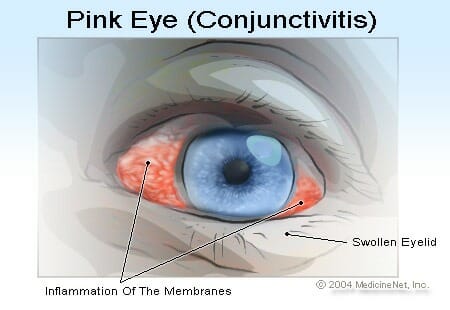Breaking Down One Common Eye Condition

Conjunctivitis, or Pink Eye
The thin, transparent layer of tissue lining the inner surface of the eyelid, as well as the covering over the white part of the eye, is known as the conjunctiva. When this layer of tissue is inflamed or infected, the result is the common eye condition known as conjunctivitis. This condition is often more commonly referred to as “pink eye.”
Conjunctivitis may affect a patient in one or both eyes, and while some forms of the condition are highly contagious, not all are. Because conjunctivitis is common in children during school years, contagious strains can spread from student to student rapidly, later affecting other family members in the home, as well. Although the condition is typically considered to be minor, more serious problems can develop as a result.
So what causes conjunctivitis? Often, the condition is caused by an infection that is either viral or bacterial in nature. An additional cause of pink eye has to do with a person’s allergies to common irritants that may be in the environment at any given time: pollen during certain seasons, pool chlorine, smoke of various types. Should a lady’s cosmetics come in contact with the eye, this could result in another allergic reaction. Though less common, STDs such as gonorrhea and Chlamydia have been known to cause conjunctivitis.
Symptoms That Are Commonly Associated With Conjunctivitis
If you are suffering from a bout with conjunctivitis, you just may be dealing with these symptoms:
- Burning sensation in one or both eyes
- Itching in one or both eyes
- Increased light sensitivity
- Discharge in one or both eyes
- Swelling in the eyelids
- A pinkish color in the white part of one or both eyes
- Excessive tearing in one or both eyes
- The feeling of grittiness in the eye
To learn more about the three main causes of conjunctivitis, allergic, infectious, or chemical, click here. Based on the nature of your particular case of conjunctivitis, optometrists may offer any number of solutions to remedy things. For instance, if the conjunctivitis is caused by an allergic irritant, then the first step would be to remove the product or element that is causing the irritation. This can range from disposing of the makeup product, or avoiding a swimming pool or smoky room. In mild cases, artificial tears and compresses may be enough to restore the eye to normal working condition.
In more aggressive cases due to infectious strains of conjunctivitis, more aggressive treatment may be required. However, antibiotics do not cure viral infections of this type. Topical steroids may be prescribed by your doctor in order to reduce the inflammation, though this will have no effect on the virus itself, which will simply have to work its way out of the body over the course of a few weeks.
For many people, preventive care may be the best bet against ever having to deal with conjunctivitis in the first place. It is advisable to altogether omit the touching of the eyes with your hands, and to wash one’s hands vigorously and as often as necessary. Making sure never to use another individual’s cosmetics is always a smart and safe practice.
[Diagram Via: medicinenet]

